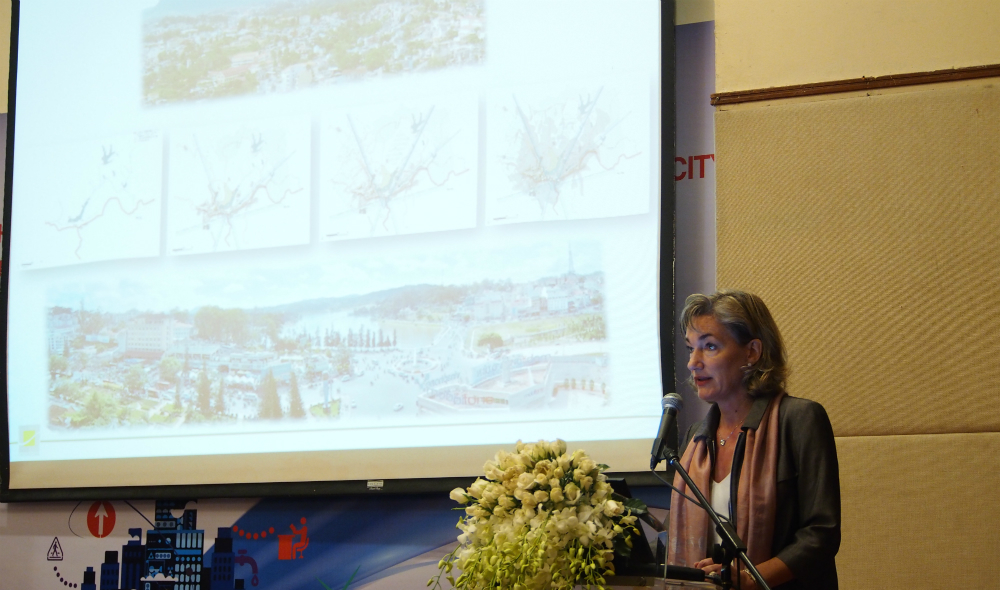Modern urban planning and architecture should be developed in a way that stays in harmony with nature, according to French experts at a recent seminar on sustainable urban planning and development in Ho Chi Minh City.
Urban planners and architects should pay more attention to solutions to integrate trees and other natural elements into their projects, as urban life should not be detached from nature, experts said at the France – Vietnam Seminar on Sustainable City co-organized by the French trade promotion office in Vietnam (UBIFRANCE Vietnam) and the HCM City Urban Development Management Support Center at the Sofitel Saigon Hotel on Wednesday.
Vietnamese urban areas should be closely linked with natural elements and use those elements as their identities, said Christine Larousse, an urban landscape architect from Paris-based Interscene Co, which is participating in the projects to preserve the old quarter of Hanoi and the master plan of greater Da Lat.
According to our philosophy in architecture, the questions of heritage values is placed at the heart of our projects due to our strong sensitivity to the unique history and culture of sites, she said at the seminar.
When we developed the master plan of greater Da Lat, our objectives were to turn Da Lat into a resort city endowed with a unique climate that can fit in the 1st category city as a result of doubling its population by 2050, she said.
In projecting to develop Da Lat this way, the city faces the double challenge of both tourism development and preserving the elements which characterize the city, including remarkable wooden landscapes, lakes and historic architectural heritages, said Larousse.
Moreover, it should maintain the exceptional quality of horticultural, floricultural and agricultural activities, she added.
In addition, it should also preserve its identities: mountains and water, she said.
“As a result, they came up with the plan to develop four hubs focusing on different and complementary functions, including the city of Da Lat, the new city of Lien Nghia, and two eco-cities of Nam Ban and Thanh My, or Quang Lap. The plan will help realize our objective.”
We applied the same philosophy when implementing the project to preserve the old quarter of Hanoi, emphasizing the close connection between old buildings with French architectural styles, old streets, new streets and the surroundings, including hundred-year-old trees, to preserve their historical values as heritages.
“We also create a linkage between parks and smalls street so that the city can turn them into walking areas in the future,” she added.
All we have done will pave the way for Hanoi to become a garden city in the future, said Larousse.
"Through our research, we paid special attention to the importance of the landscape, especially the identity of the landscape. This means that we have to consider the uniqueness of the landscape,” she said.
Urban areas of Vietnam should emphasize the unique features of the landscape. That will make your cities attractive, she added.
The French architects also stressed the importance of cultural heritage for the sustainable development of the cities of Vietnam, and this can be applied to any city in the world.
New approaches
French architect Jonathan Thornhill, from Loci Anima Co, also suggested the development of urban areas vertically to set aside land for trees and public spaces.
According to Thornhill, a city, which is expanded in a normal way without good controlling mechanisms will be unsustainable and will not guarantee a good living environment for people.
If choosing the compression approach for urban development by reducing building area and increasing building height, there will be more land for planting trees in urban areas, while protecting the ecology of the surrounding metropolitan area, according to Antoine Mougenot, a French expert in planning from AREP Vietnam Co.
In addition, to develop a vertical urban area in a sustainable way, architect Julien Schnell, director of Urbanica, said when in the planning process, planners should pay attention to the connection between buildings and public transport systems and design the underground spaces so that they have access to wind and natural light.
|
In the framework of the seminar, 10 French companies introduced innovative solutions in the field of architectural design, urban planning, sustainable building and green building. The French firms will have private meetings, held by UBIFRANCE Vietnam, with local partners. UBIFRANCE is the trade mission aimed at supporting the international development of French businesses. With a growing system of 80 offices worldwide, UBIFRANCE supports French companies in the export of its products in 70 countries. |
Like us on Facebook or follow us on Twitter to get the latest news about Vietnam!




















































